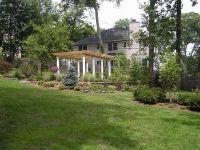Amazing map of NJ racial distribution by census block level
Chopin...fascinating link. South Orange neighborhoods are three of the top 10 by his criteria.
(to your point, some of the neighborhood names are strange...but I believe the old Pierson home is named Vauxhall, so that neighborhood name probably refers to some of the area of Maplewood near it, rather than to the area we generally call Vauxhall. If you click into his article on South Orange, the neighborhood names are appropriate)
On some maps from the 20's and 30's the area around Clinton school was referred to as Newark Heights.
Urban planning plays a role here. South Orange is bisected from east to west by South Orange, which connects easily and directly with the eastern parts of Essex County that are well known for their high black population. The analogous road in Maplewood is Springfield Avenue, which does not bisect the town but rather runs at an angle that naturally divides the town into isolated parts.
Those streets are both some of the oldest in the towns, so not really an urban planning issue, as much as a much more complex century of suburban/urban evolution.
I was referring to the design and location of the roads. Building a road is urban planning. It doesn't matter when it happened.
jfburch said:
Those streets are both some of the oldest in the towns, so not really an urban planning issue, as much as a much more complex century of suburban/urban evolution.
South Orange Ave and Irvington Ave were both Lenni Lenape trails that were in existence long before Europeans arrived here. Obviously they didn't have the same names then that they do now. I don't know about Springfield Ave though, that one I will have to research.
In the 10 years on my block, every AA family that has moved was replaced with a white family =( I hope there are real estate agents that can tap into the stream of AA families looking to move to the burbs like we now see them doing with families from Brooklyn.
ctrzaska said:
Details such as?
E.g., "the opposite" of what, precisely?
I understand that there may be some hesitance to state some things plainly, but relative newcomers to the area may lack info about historical trends, either demonstrable or as perceived by longer-term residents.
The opposite of the trend cited in the post immediately above, which is what I was responding to. What's the opposite of "white flight"? If there's a name for that, then that's your answer.
The only hesitance comes from trying to decipher veiled questions.
spontaneous -- Some older maps I have seen refer to the area around the intersection of Springfield and Burnett Aves. as "Newark Heights." That is because there was a branch railroad between Burnett and Boyden that ended behind Woolley Fuel that had a freight stop called Newark Heights. I have had arguments in other threads about whether that line ever carried passengers (I don't remember the correct answer) and whether the actual neighborhood was ever called Newark Heights (I'm still dubious about that). I don't want to get back into that. The only maps I have seen that put a label of "Newark Heights" considerably to the north around Clinton School are ones from the computer age where some computer glitch has transposed names considerably north of where they should be, as in my bizarre examples including Vauxhall (transposed to the Roosevelt Park and adjoining areas west of Ridgewood Rd. in Maplewood) and Newstead (transposed 2 miles or more to the north in West Orange).
susan1014 --You're right about the Pierson home being the original "Vauxhall." I was aware of that.
Folks should be aware that many maps on the internet have major errors of the kind you rarely used to see on maps.
ctrzaska said:
The opposite of the trend cited in the post immediately above, which is what I was responding to. What's the opposite of "white flight"? If there's a name for that, then that's your answer.
The only hesitance comes from trying to decipher veiled questions.
Thanks for the indecipherable veiled non-answer.
A guy affiliated with the CCR did a study of mortgage applications in the Hilton area in, from memory, the early 00s and the study indicated that more whites were applying for mortgages in that area than was the case in the 1990s. I don't have the details and the above is from memory. Since I don't hang out in MW very often anymore I can't comment on the current situation.
The map errors mentioned above have been around for a long time. I think when the maps began to show up on search engines they came straight from the publishers like Rand McNally.
How can you call it real estate discrimination?
Isn't it just nature/organic, where people choose to live and can afford? Did you ever thing that maybe these things are better dealt with organically rather than realtors or other factors or you, forcing people of a certain race to live somewhere so that areas can say "we are diverse"? Isn't that reverse discrimination in itself? I know you always add very valuable insight here so i'm a bit surprised at the comment re you thought "Maplewood had done a bit better"..is it Maplewood's fault?
susan1014 said:
RobB said:I won't light you up...I'm actually only a little shocked.
susan1014 said:At the risk of being lit up.
shocked to see just how white some parts of Maplewood are.
I'm not shocked.
I just thought that Maplewood had done a bit better than that at recovering from the bad old days when it had lots of real estate discrimination, while South Orange was more open to Jews and people of color.
It startles me to think how much less diverse the mix of complexions is on streets just a few blocks from mine.
Not that it matters to this discussion, but S.O. Ave. is much older than Springfield Avenue. I don't know if S.O. Ave. goes back to the Leni Lenape (some info on S.O. websites is questionable), but I believe it goes back at least to colonial times, as does Ridgewood Rd. and some of Valley St. My memory is that Springfield Ave. was laid out in 1806 (I think as a toll road -- a "turnpike"). Bloomfield Avenue and (I believe) Central Avenue, south of Main St. in the Oranges, were laid out at the same time. That era was one of great road building in all over North Jersey. I'm guessing Park Avenue, north of Main St., was laid out considerably later to connect Llewelyn Park's main gate to downtown Newark. For those who may not know, L.P. is arguably the nation's oldest planned suburb (it has at least one competitor to that title, by maybe a year) laid out in 1853. L.P.'s most famous resident right now would probably be Whoopie Goldberg.
Does anyone have any idea when the Vauxhall section of Union became majority African-American? My impression is that it has been overwhelmingly AA since at least the end of WWII. I understand that one of Columbia High School's most prominent graduates, Amalya Kearse, was actually from Vauxhall. I would love to know more about her life story. I wonder if she was ever considered for the Supreme Court. If it had been up to me, I would have put her on the Supremes.
bobk -- Some maps on the internet may have originally come from Rand McNally and Hammond (a Maplewood institution for those of you new to SOMA), but I don't remember ever seeing those kinds of errors on the published maps. The errors I referred to can come from no other source than a computer transposition glitch, moving a group of labels thousands of feet in real life (inches on the maps) from the correct location. I became aware of this kind of glitch with a map I was actually working with on the computer, when I must have pressed a wrong button (I'm pretty computer-illiterate -- is that the right word?) and caused just this kind of transposition.
The Rahway Valley Railroad was the owner and operator of the Newark Heights branch from 1911 until 1973. It was a freight only branch although the internet abounds with rumors that the company planned to build a passenger station around 126 Tuscan Road, next to the Wooley property.
Regarding the name Newark Heights name, the only evidence I've seen it on a map is this one from 1922: http://www.historicmapworks.com/Map/US/1249016/Plate+020/Essex+County+1928+Vol+4/New+Jersey/
You can see there is a business named the "Newark Heights Supply Co." My theory, based on very little is that the company built some of the first houses in the area and the name stuck around. That said you can see on the map that several streets are overlain with developers names, so they almost certainly did not build the entire area on their own.
Starsong, it is widely documented that Maplewood (more so than South Orange) once had very serious real estate discrimination, which was one of the major reasons for the formation of the CCR.
I think that the current difference in patterns does indeed show that this sort of difference is very long-lived, even when the actual discrimination ends (although I do remember in the mid 1990s our realtor giving us the sense that we might be less comfortable on the east side of Maplewood...not overt steering, but still a residue).
Of course no one should be forced to live somewhere just to say "we are diverse"...but I'd also say that Maplewood's sense of self in the area of diversity may outstrip the reality of the situation. I had optimistically thought that the housing patterns were no longer quite so split.
(When I said "Maplewood" I meant the aggregate population, not the Town government)
Starsong said:
How can you call it real estate discrimination?
Isn't it just nature/organic, where people choose to live and can afford? Did you ever thing that maybe these things are better dealt with organically rather than realtors or other factors or you, forcing people of a certain race to live somewhere so that areas can say "we are diverse"? Isn't that reverse discrimination in itself? I know you always add very valuable insight here so i'm a bit surprised at the comment re you thought "Maplewood had done a bit better"..is it Maplewood's fault?
susan1014 said:
RobB said:I won't light you up...I'm actually only a little shocked.
susan1014 said:At the risk of being lit up.
shocked to see just how white some parts of Maplewood are.
I'm not shocked.
I just thought that Maplewood had done a bit better than that at recovering from the bad old days when it had lots of real estate discrimination, while South Orange was more open to Jews and people of color.
It startles me to think how much less diverse the mix of complexions is on streets just a few blocks from mine.
mff said:
ctrzaska said:Thanks for the indecipherable veiled non-answer.
The opposite of the trend cited in the post immediately above, which is what I was responding to. What's the opposite of "white flight"? If there's a name for that, then that's your answer.
The only hesitance comes from trying to decipher veiled questions.
Then just ask a straightforward question instead of baiting. I'll wait, presuming you wish to reveal what you've clearly read into my comments.
But in the interim, and phrased more succinctly for your comprehension.... According to bobk's post, the white middle class moved out of the area in the 90s as an example of white flight. Maybe so, maybe not. In any case, the white middle class is moving back into this diverse area at a higher historical rat, clearly with a mindset quite opposite of those who chose to leave a decade or two earlier. Better now?
ctrzaska said:Then just ask a straightforward question instead of baiting. I'll wait, presuming you wish to reveal what you've clearly read into my comments.But in the interim, and phrased more succinctly for your comprehension.... According to bobk's post, the white middle class moved out of the area in the 90s as an example of white flight. Maybe so, maybe not. In any case, the white middle class is moving back into this diverse area at a higher historical rat, clearly with a mindset quite opposite of those who chose to leave a decade or two earlier. Better now?
I thoroughly hate the sport of fishing--and was on the contrary asking straightforwardly, sorry you are disposed not to see it for such.
Defensive as you are, I presume that the "higher historical rat" slip was just a typo.
Straightforwardly? I wonder what fails to meet the bar for circuitous. Anyhoo, I've enjoyed the assumptions, whether concerning my hesitancy to speak plainly (of what?), my disposition, or my defensiveness. At least you got the last one right, regardless of the impossible context were it intentionally typed that way. So there's that. Glad you received the answer you sought. Do let me know if there's anything else.
I don't recall where I saw it, but I questioned the Clinton school area being Newark Heights once since FB keeps posting that I am there. Someone showed a link to an old map made around the time my area was being planned out and it showed this area, Clinton School, as being Newark Heights.
ctrzaska said:Hardly need you when there's Trump
Straightforwardly? I wonder what fails to meet the bar for circuitous. Anyhoo, I've enjoyed the assumptions, whether concerning my hesitancy to speak plainly (of what?), my disposition, or my defensiveness. At least you got the last one right, regardless of the impossible context were it intentionally typed that way. So there's that. Glad you received the answer you sought. Do let me know if there's anything else.
to chalk every movement.
LOL. How incisive. Amateur hour, clearly, and not worth my time. I'll not be responding to your insipid commentary any further, but by all means carry on.
Bee said:
My GPS on my phone sometimes says 'Newark heights'
When we were first looking to move here 3 years ago Trulia.com and Realtor.com did the same.
I do know that like it or not, our taxes support CCR so with that logic perhaps its time to recognize that maybe they are not meeting their goals and to stop funding? Or at least seek private/choice funding? Perhaps another conversation..
Regarding SO vs Maplewood, why must we always stack one against the other in comparisons? We share the schools (which I believe also was an attempt to force integration?--seems still not working per your assessment now?) . We are two very different beautiufl towns, I love them both but would choose one over the other just based on my needs/likes/and most importantly, choice. It doesn't do the other town justice when its it always compared to it's neighbor. They are different towns with different zip codes, and different downtowns, different government --perhaps it's time to give each it's credence and let them have their own wonderful records without comparing to the neighbor?
susan1014 said:
Starsong, it is widely documented that Maplewood (more so than South Orange) once had very serious real estate discrimination, which was one of the major reasons for the formation of the CCR.
I think that the current difference in patterns does indeed show that this sort of difference is very long-lived, even when the actual discrimination ends (although I do remember in the mid 1990s our realtor giving us the sense that we might be less comfortable on the east side of Maplewood...not overt steering, but still a residue).
Of course no one should be forced to live somewhere just to say "we are diverse"...but I'd also say that Maplewood's sense of self in the area of diversity may outstrip the reality of the situation. I had optimistically thought that the housing patterns were no longer quite so split.
(When I said "Maplewood" I meant the aggregate population, not the Town government)
Starsong said:
How can you call it real estate discrimination?
Isn't it just nature/organic, where people choose to live and can afford? Did you ever thing that maybe these things are better dealt with organically rather than realtors or other factors or you, forcing people of a certain race to live somewhere so that areas can say "we are diverse"? Isn't that reverse discrimination in itself? I know you always add very valuable insight here so i'm a bit surprised at the comment re you thought "Maplewood had done a bit better"..is it Maplewood's fault?
susan1014 said:
RobB said:I won't light you up...I'm actually only a little shocked.
susan1014 said:At the risk of being lit up.
shocked to see just how white some parts of Maplewood are.
I'm not shocked.
I just thought that Maplewood had done a bit better than that at recovering from the bad old days when it had lots of real estate discrimination, while South Orange was more open to Jews and people of color.
It startles me to think how much less diverse the mix of complexions is on streets just a few blocks from mine.
I never heard that the schools were shared to force integration. I always assumed the schools were shared because up until 1922 Maplewood was part of South Orange and keeping the school system shared was just easier than trying to divvy everything up when the towns became separate. Plus had the school systems not stayed merged then South Orange would have had to build a new high school.
Starsong said:
I do know that like it or not, our taxes support CCR so with that logic perhaps its time to recognize that maybe they are not meeting their goals and to stop funding? Or at least seek private/choice funding? Perhaps another conversation..
Regarding SO vs Maplewood, why must we always stack one against the other in comparisons? We share the schools (which I believe also was an attempt to force integration?--seems still not working per your assessment now?) . We are two very different beautiufl towns, I love them both but would choose one over the other just based on my needs/likes/and most importantly, choice. It doesn't do the other town justice when its it always compared to it's neighbor. They are different towns with different zip codes, and different downtowns, different government --perhaps it's time to give each it's credence and let them have their own wonderful records without comparing to the neighbor?
Starsong, I've never known the residents of Maplewood to avoid comparisons with South Orange when they want to do so (e.g. on downtown charm). I don't know of a good way to discuss this issue without highlighting the differences, which show up clearly on the maps. Sorry if that touches a nerve.
Both are lovely towns, and I would happily live in either, but that doesn't mean that I'll refuse to talk about difficult topics. The complexities of our racial issues impact me every single day as a parent of school-age children, so I have an obvious interest in the realities and history of our two towns.
(and spontaneous is right about the history of our shared system, I believe)
Rentals
-
Huge Brand New construction Apartment in 2 family home with 4 bedrooms 3 bathrooms
4 Bd | 3Full Ba
$4,500
Sponsored Business
Promote your business here - Businesses get highlighted throughout the site and you can add a deal.





















I just looked at the Higley site again. There may be major errors. For instance, he puts Vauxhall in Maplewood and bizarrely says its average income is above the Wyoming section of Millburn. I suspect he was using some lame internet map (like those I have seen) that puts "Vauxhall" in western Maplewood, "Newark Heights" around Clinton School, and Newstead in northern West Orange. While the Higley site does have some info about integrated neighborhoods, I may have confused it with another site that I thought was completely about considerably black neighborhoods.